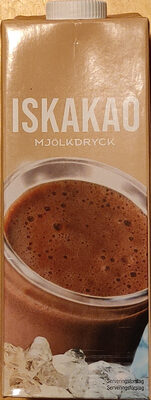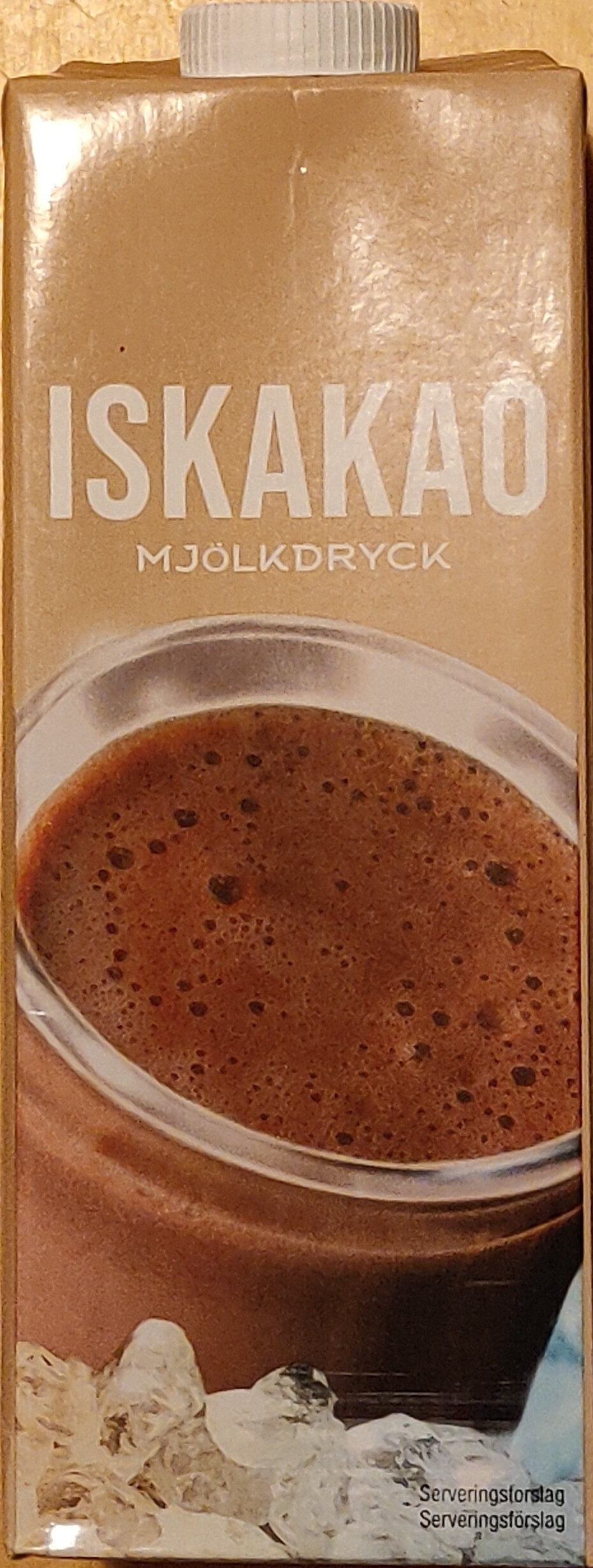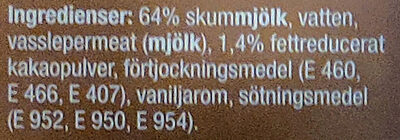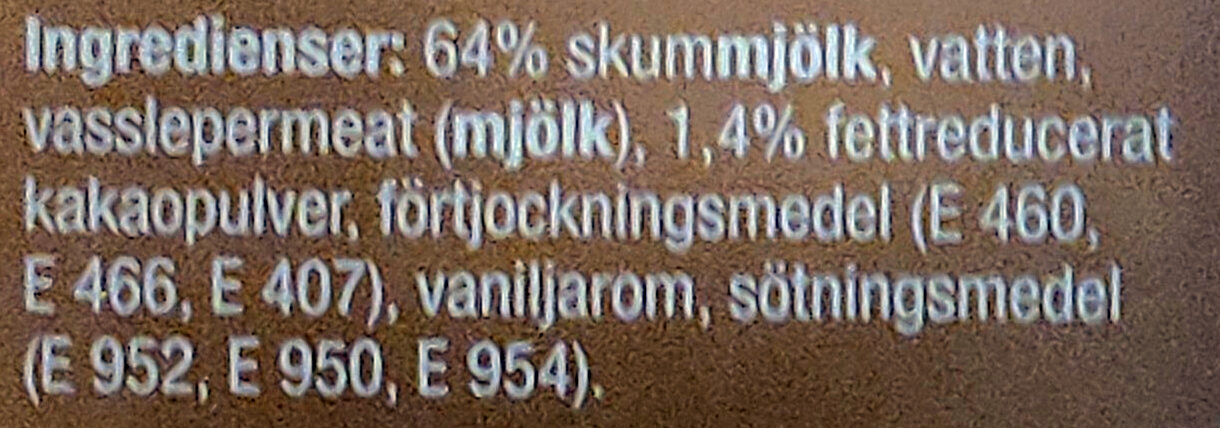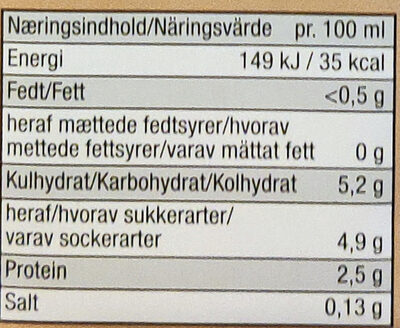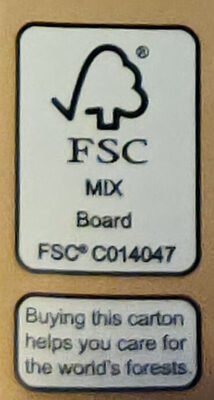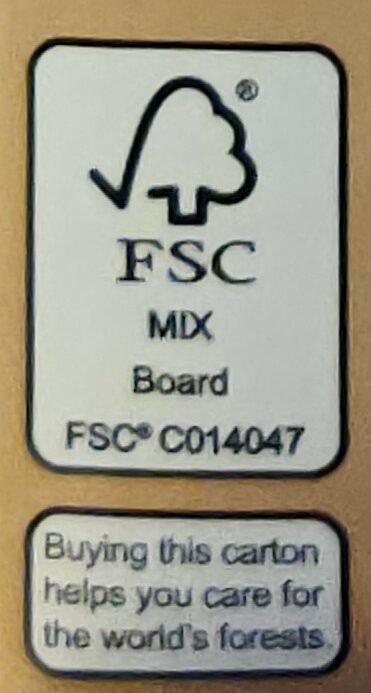Help us make food transparency the norm!
As a non-profit organization, we depend on your donations to continue informing consumers around the world about what they eat.
The food revolution starts with you!
Iskakao - Geia Food - 1 L
Iskakao - Geia Food - 1 L
Streckkod: 7350024489156 (EAN / EAN-13)
Vanligt namn: Mjölkdryck med kakao. Innehåller sötningsmedel. UHT-behandlad.
Kvantitet: 1 L
Förpackning: Papper, Tetra Pak, en:FSC paper
Varumärken: Geia Food, Geia Food A/S
Kategorier: Drycker, Mejeriprodukt, en:Dairy drinks, en:Artificially sweetened beverages, en:Flavoured milks, Chokladmjölk
Etiketter, certifieringar, utmärkelser:
en:FSC, en:FSC Mix, en:FSC C014047
Ingredients ursprung: Tyskland
Tillverknings eller bearbetningsplats: Tyskland, Germany, Deutschland
Spårbarhetskod: DE HE-001 EG, FSC-C014047
Butiker: Hemköp
Länder där såld: Sverige
Matching with your preferences
Hälsa
Ingredienser
-
13 ingredienser
64% skummjölk, vatten, vasslepermeat (mjölk), 1,4% fettreducerat kakaopulver, förtjockningsmedel (E 460, E 466, E 407), vaniljarom, sötningsmedel (E 952, E 950, E 954).Allergener: Mjölk
Food processing
-
Ultra processed foods
Elements that indicate the product is in the 4 - Ultra bearbetade livsmedel och drycker group:
- Tillsats: E407 - Karragenan
- Tillsats: E460 - Cellulosa
- Tillsats: E466 - Karboximetylcellulosa
- Tillsats: E950 - Acesulfam k
- Tillsats: E952 - Cyklaminsyra och dess na- och ca-salter
- Tillsats: E954 - Saccharin and its na. k and ca salts
- Ingrediens: Arom
- Ingrediens: Sötningsmedel
- Ingrediens: Förtjockningsmedel
- Ingrediens: Vassle
Food products are classified into 4 groups according to their degree of processing:
- Obearbetade eller minimalt bearbetade livsmedel
- Bearbetade kulinariska ingredienser
- Halvfabrikat
- Ultra processed foods
The determination of the group is based on the category of the product and on the ingredients it contains.
Tillsatser
-
E407 - Karragenan
Carrageenan: Carrageenans or carrageenins - karr-ə-gee-nənz, from Irish carraigín, "little rock"- are a family of linear sulfated polysaccharides that are extracted from red edible seaweeds. They are widely used in the food industry, for their gelling, thickening, and stabilizing properties. Their main application is in dairy and meat products, due to their strong binding to food proteins. There are three main varieties of carrageenan, which differ in their degree of sulfation. Kappa-carrageenan has one sulfate group per disaccharide, iota-carrageenan has two, and lambda-carrageenan has three. Gelatinous extracts of the Chondrus crispus -Irish moss- seaweed have been used as food additives since approximately the fifteenth century. Carrageenan is a vegetarian and vegan alternative to gelatin in some applications or may be used to replace gelatin in confectionery.Källa: Wikipedia (Engelska)
-
E460 - Cellulosa
Cellulose: Cellulose is an organic compound with the formula -C6H10O5-n, a polysaccharide consisting of a linear chain of several hundred to many thousands of β-1→4- linked D-glucose units. Cellulose is an important structural component of the primary cell wall of green plants, many forms of algae and the oomycetes. Some species of bacteria secrete it to form biofilms. Cellulose is the most abundant organic polymer on Earth. The cellulose content of cotton fiber is 90%, that of wood is 40–50%, and that of dried hemp is approximately 57%.Cellulose is mainly used to produce paperboard and paper. Smaller quantities are converted into a wide variety of derivative products such as cellophane and rayon. Conversion of cellulose from energy crops into biofuels such as cellulosic ethanol is under development as a renewable fuel source. Cellulose for industrial use is mainly obtained from wood pulp and cotton.Some animals, particularly ruminants and termites, can digest cellulose with the help of symbiotic micro-organisms that live in their guts, such as Trichonympha. In human nutrition, cellulose is a non-digestible constituent of insoluble dietary fiber, acting as a hydrophilic bulking agent for feces and potentially aiding in defecation.Källa: Wikipedia (Engelska)
-
E466 - Karboximetylcellulosa
Carboxymethyl cellulose: Carboxymethyl cellulose -CMC- or cellulose gum or tylose powder is a cellulose derivative with carboxymethyl groups --CH2-COOH- bound to some of the hydroxyl groups of the glucopyranose monomers that make up the cellulose backbone. It is often used as its sodium salt, sodium carboxymethyl cellulose.Källa: Wikipedia (Engelska)
-
E950 - Acesulfam k
Acesulfame potassium: Acesulfame potassium - AY-see-SUL-faym-, also known as acesulfame K -K is the symbol for potassium- or Ace K, is a calorie-free sugar substitute -artificial sweetener- often marketed under the trade names Sunett and Sweet One. In the European Union, it is known under the E number -additive code- E950. It was discovered accidentally in 1967 by German chemist Karl Clauss at Hoechst AG -now Nutrinova-. In chemical structure, acesulfame potassium is the potassium salt of 6-methyl-1‚2,3-oxathiazine-4-3H--one 2‚2-dioxide. It is a white crystalline powder with molecular formula C4H4KNO4S and a molecular weight of 201.24 g/mol.Källa: Wikipedia (Engelska)
-
E952 - Cyklaminsyra och dess na- och ca-salter
Cyclamic acid: Cyclamic acid is a compound with formula C6H13NO3S. It is included in E number "E952". Cyclamic acid is mainly used as catalyst in the production of paints and plastics, and furthermore as a reagent for laboratory usage.The sodium and calcium salts of cyclamic acid are used as artificial sweeteners under the name cyclamate.Källa: Wikipedia (Engelska)
-
E954 - Saccharin and its na. k and ca salts
Saccharin: Sodium saccharin -benzoic sulfimide- is an artificial sweetener with effectively no food energy. It is about 300–400 times as sweet as sucrose but has a bitter or metallic aftertaste, especially at high concentrations. Saccharin is used to sweeten products such as drinks, candies, cookies, and medicines.Källa: Wikipedia (Engelska)
Ingrediensanalys
-
Palmoljefri
No ingredients containing palm oil detected
-
Icke-vegan
Non-vegan ingredients: Skummjölk, Vasslepermeat
-
Kanske Vegetariskt
Ingredients that may not be vegetarian: Vasslepermeat, Vaniljarom
-
Details of the analysis of the ingredients
: _skummjölk_ 64%, vatten, vasslepermeat, fettreducerat kakaopulver 1.4%, förtjockningsmedel (e460, e466, e407), vaniljarom, sötningsmedel (e952, e950, e954)- _skummjölk_ -> en:skimmed-milk - vegan: no - vegetarian: yes - ciqual_proxy_food_code: 19051 - percent_min: 64 - percent: 64 - percent_max: 64
- vatten -> en:water - vegan: yes - vegetarian: yes - ciqual_food_code: 18066 - percent_min: 6 - percent_max: 33.2
- vasslepermeat -> en:whey-permeate - vegan: no - vegetarian: maybe - percent_min: 1.4 - percent_max: 28.6
- fettreducerat kakaopulver -> en:fat-reduced-cocoa-powder - vegan: yes - vegetarian: yes - ciqual_food_code: 18100 - percent_min: 1.4 - percent: 1.4 - percent_max: 1.4
- förtjockningsmedel -> en:thickener - percent_min: 0 - percent_max: 1.4
- e460 -> en:e460 - vegan: yes - vegetarian: yes - percent_min: 0 - percent_max: 1.4
- e466 -> en:e466 - vegan: yes - vegetarian: yes - percent_min: 0 - percent_max: 0.7
- e407 -> en:e407 - vegan: yes - vegetarian: yes - percent_min: 0 - percent_max: 0.466666666666667
- vaniljarom -> en:vanilla-flavouring - vegan: maybe - vegetarian: maybe - percent_min: 0 - percent_max: 1.4
- sötningsmedel -> en:sweetener - percent_min: 0 - percent_max: 1.4
- e952 -> en:e952 - vegan: yes - vegetarian: yes - percent_min: 0 - percent_max: 1.4
- e950 -> en:e950 - vegan: yes - vegetarian: yes - percent_min: 0 - percent_max: 0.7
- e954 -> en:e954 - vegan: yes - vegetarian: yes - ciqual_food_code: 31064 - percent_min: 0 - percent_max: 0.466666666666667
Näring
-
Poor nutritional quality
⚠ ️Varning: mängden fibrer är inte angiven, eventuella positiv inverkan på betyget kunde inte beaktas.⚠ ️Warning: the amount of fruits, vegetables and nuts is not specified on the label, it was estimated from the list of ingredients: 0This product is considered a beverage for the calculation of the Nutri-Score.
Positiva poäng: 1
- Proteiner: 1 / 5 (värde: 2.5, avrundat värde: 2.5)
- Fiber: 0 / 5 (värde: 0, avrundat värde: 0)
- Frukt, grönsaker, nötter och raps- / valnöt- / olivoljor: 0 / 10 (värde: 0, avrundat värde: 0)
Negativa poäng: 9
- Energi: 5 / 10 (värde: 149, avrundat värde: 149)
- Socker: 4 / 10 (värde: 4.9, avrundat värde: 4.9)
- Mättat fett: 0 / 10 (värde: 0, avrundat värde: 0)
- Natrium: 0 / 10 (värde: 52, avrundat värde: 52)
The points for proteins are counted because the negative points are less than 11.
Näringsvärde: (9 - 1)
Nutri-Score:
-
Näringsvärden
-
Fett i låg kvantitet (0.5%)
What you need to know- A high consumption of fat, especially saturated fats, can raise cholesterol, which increases the risk of heart diseases.
Recommendation: Limit the consumption of fat and saturated fat- Choose products with lower fat and saturated fat content.
-
Mättat fett i låg kvantitet (0%)
What you need to know- A high consumption of fat, especially saturated fats, can raise cholesterol, which increases the risk of heart diseases.
Recommendation: Limit the consumption of fat and saturated fat- Choose products with lower fat and saturated fat content.
-
Sockerarter i måttlig kvantitet (4.9%)
What you need to know- A high consumption of sugar can cause weight gain and tooth decay. It also augments the risk of type 2 diabetes and cardio-vascular diseases.
Recommendation: Limit the consumption of sugar and sugary drinks- Sugary drinks (such as sodas, fruit beverages, and fruit juices and nectars) should be limited as much as possible (no more than 1 glass a day).
- Choose products with lower sugar content and reduce the consumption of products with added sugars.
-
Salt i låg kvantitet (0.13%)
What you need to know- A high consumption of salt (or sodium) can cause raised blood pressure, which can increase the risk of heart disease and stroke.
- Many people who have high blood pressure do not know it, as there are often no symptoms.
- Most people consume too much salt (on average 9 to 12 grams per day), around twice the recommended maximum level of intake.
Recommendation: Limit the consumption of salt and salted food- Reduce the quantity of salt used when cooking, and don't salt again at the table.
- Limit the consumption of salty snacks and choose products with lower salt content.
-
-
Näringsfakta
Näringsfakta Som såld
för 100 g / 100 mlCompared to: Chokladmjölk Energi 149 kj
(35 kcal)−46 % Fett < 0,5 g −63 % Mättat fett 0 g −100 % Kolhydrat 5,2 g −42 % Sockerarter 4,9 g −41 % Fiber ? Protein 2,5 g −34 % Salt 0,13 g +12 % Fruits‚ vegetables‚ nuts and rapeseed‚ walnut and olive oils (estimate from ingredients list analysis) 0 %
Miljö
-
Eco-Score C - Måttlig miljöpåverkan
The Eco-Score is an experimental score that summarizes the environmental impacts of food products.→ The Eco-Score was initially developped for France and it is being extended to other European countries. The Eco-Score formula is subject to change as it is regularly improved to make it more precise and better suited to each country.Life cycle analysis
-
Average impact of products of the same category: C (Score: 49/100)
Kategori: Chocolate flavoured milk, with sugar, partially skimmed, fortified with vitamins and chemicals elements
- PEF environmental score: 0.16 (the lower the score, the lower the impact)
- including impact on climate change: 1.38 kg CO2 eq/kg of product
Stage Impact Jordbruk
56.9 %Bearbetar
0.9 %Förpackning
24.9 %Transportation
10.1 %Distribution
5.7 %Consumption
1.6 %
Bonuses and maluses
-
Origins of ingredients with a medium impact
Bonus: +10
Environmental policy: +4
Transportation: +6
Origin of the product and/or its ingredients % of ingredients Impact Tyskland 100 %Medium
-
Packaging with a low impact
Malus: -4
Form Material Återvinning Impact Brick Tetra Pak Medium
Eco-Score for this product
-
Impact for this product: C (Score: 55/100)
Produkt: Iskakao - Geia Food - 1 L
Life cycle analysis score: 49
Sum of bonuses and maluses: +6
Final score: 55/100
-
Carbon footprint
-
Equal to driving 0.7 km in a petrol car
138 g CO² per 100g of product
The carbon emission figure comes from ADEME's Agribalyse database, for the category: Chocolate flavoured milk, with sugar, partially skimmed, fortified with vitamins and chemicals elements (Source: ADEME Agribalyse Database)
Stage Impact Jordbruk
68.6 %Bearbetar
0.8 %Förpackning
12.9 %Transportation
14.7 %Distribution
2.6 %Consumption
0.5 %
Förpackning
-
Packaging with a low impact
-
Packaging parts
Brick (Tetra Pak)
-
Packaging materials
Material % Packaging weight Packaging weight per 100 g of product
-
Transportation
-
Origins of ingredients
Origins of ingredients with a medium impact
Origin of the product and/or its ingredients % of ingredients Impact Tyskland 100 %Medium
Report a problem
-
Incomplete or incorrect information?
Category, labels, ingredients, allergens, nutritional information, photos etc.
If the information does not match the information on the packaging, please complete or correct it. Open Food Facts is a collaborative database, and every contribution is useful for all.
Datakällor
Produkt tillagd den av akitainu
Senast ändrad produktsida på av akitainu.
Produktsida också redigerad av ecoscore-impact-estimator, openfoodfacts-contributors, roboto-app.
